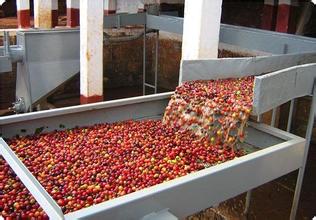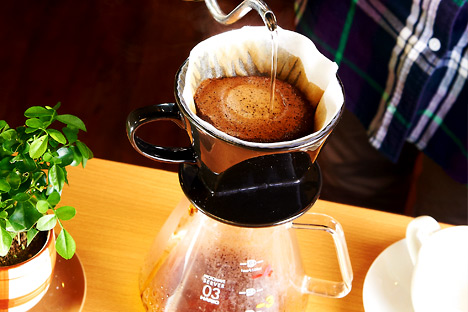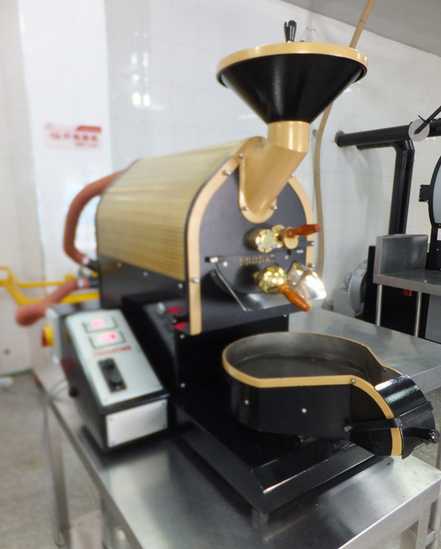Treatment of raw coffee beans: introduction to the operation method and purpose of washing method

Washing method:
1. Choose beans:
Put the harvested fruit in a water tank and soak for about 24 hours. At this time, ripe fruit will sink, while immature and overripe fruit will float up and can be removed.
2. Remove the pulp:
Use a machine to remove the peel and pulp, leaving only coffee beans wrapped in endocarp. At this time, there is a layer of mucous membrane on the outside of the beans, and the process of washing is to wash this layer of mucous membrane.
3, hair alcohol:
The adhesion of the mucous membrane is very strong and is not easy to remove. It must be placed in the slot for about 18-36 hours to make it alcohol and decompose the mucous membrane. There are two methods of fermentation, namely wet hair alcohol and dry hair alcohol, as the name implies, the former adds water, the latter does not add water. In the process of producing alcohol, the seeds and internal pulp will produce special changes, which is one of the steps that most affect the flavor of coffee. Some farms add hot water or alkanolins to speed up the production of alcohol, which has a negative impact on quality and is not popular with selected coffee lovers.
4, washing:
Farms that use the washing method must build washing ponds and be able to introduce an endless supply of running water. During the treatment, the finished beans are put into the pool and passed back and forth, using the friction of beans and the power of running water to wash the coffee beans until smooth and clean.
5, dry:
After washing, at this time, the coffee beans are still wrapped in the pericarp with a moisture content of 50%. They must be dried to reduce the moisture content to 12%, otherwise they will continue to be mellow, moldy and rotten. The better treatment is to use sunlight to dry, although it will take 1-3 weeks, but the flavor is very good and very popular. In addition, machine drying is used in some places, which greatly shortens the processing time and makes the flavor not as good as that of sun-dried coffee.
6, shelling:
The dried beans can be stored in a warehouse or handed over to the factory for shelling to remove endocarp and silver film.
7, selection and grading:
Like tanning hair, washed coffee has a process of picking and grading, which is used to remove defective beans and ensure better quality, which is then handed over to exporters to sell around the world.
Washing method: good gloss, less foreign body mixed, slightly better sour taste, Colombia, Mexico, Guatemala use this method. Disadvantages: poor handling of time will produce bad smell and special sour smell.
The picked coffee cherries, including freshly ripe, overripe, and unripe ones, are all mixed together. If these coffee cherries are not treated separately, the quality of the coffee beans is really unpalatable, because it is mixed with a lot of bad-tasting impurities. So these coffee cherries should be washed and placed in a large trough full of water for preliminary classification. The best coffee has a high density, so it sinks into the water. On the other hand, overripe coffee cherries will surface and can be easily classified. Remove the pulp from the outer layer of the coffee cherry and then soak it in a large sink filled with water. After fermentation, the water-washed coffee will have a distinctive and clear flavor. The fermented coffee beans are washed with clean water, then removed from the water and dried in the sun or machine. Finally, the peel and silver peel are removed by a sheller, which can be screened and divided into different grades of raw coffee beans.
Washing requires the use of special machinery and equipment and adequate water sources. When properly treated, the special characteristics of coffee beans can be more highlighted. In addition, the number of bad beans can also be removed in large numbers during the washing process, so that the quality of coffee beans can be improved. The procedure of washing coffee is widely used in Central and South American countries.
When the coffee fruit is harvested from the mountain, the next step is to remove the peel and pulp of the coffee beans. There are two main ways of treatment: washing and solarization. But the ultimate determining factor is whether there is enough water to use. Some special boutique coffees are both insolated and washed.
The peel and pulp separated from the coffee beans will be washed off with water. The flushing tank is designed to separate light and tender coffee beans from thick and ripe coffee beans. This kind of separation can also be done by the "Austrian high score machine". Ogao, a coffee grower in Norway, designed a device to filter coffee beans into a large water container while growing coffee in Kenya. The large, full beans were the first to sink into the water, while the lighter beans stayed in the large container. In this process, water can be recycled.
The next step is the most basic fermentation, that is, the use of enzymes to separate the greasy glue that covers the inner pericarp. Coffee beans are stored in a fermentor for about 12-36 hours, which is mainly determined by the surrounding temperature, the thickness of the glue and the enzyme. When this process is completed, the endocarp around the coffee beans is no longer slippery but has a pebble-like feel.
In the whole wet treatment process, quality control is very important to prevent coffee tofu from rotting, because even one rotten coffee bean may damage all coffee beans. For this reason, the equipment used must be cleaned every day to ensure that no impurities are left before the next round of processing.
After the coffee beans are harvested, they will first make a simple selection to remove impurities. After that, a truckload of trucks will carry the coffee beans into a large sink, and clean and flowing water will wash the coffee beans into the waterway. Ripe coffee beans should be dense and sink under the waterway. Damaged coffee fruits, branches, leaves, and lighter impurities float on the water surface and are isolated and removed by a filter above the waterway.
After being washed and sorted in the waterway, the pulp of the ripe fruit will be removed by the pulp remover. This step is the most different from sun-cured coffee, because the pulp and beans are separated before the sun.
At this time, the outer layer of the coffee bean is covered with a layer of sticky soft parchment, which can protect the integrity of the coffee bean. The washing process should be carried out immediately after the coffee is harvested to avoid taste contamination caused by pulp decay and the deterioration of the quality of the coffee beans.
After that, the coffee beans are placed on a mechanical strainer. The shaken strainer will separate the immature beans and bad beans that were not separated in the previous washing step. Successfully filtered coffee beans are put into the waterway for the second time and cleaned and sorted again with clean water.
Due to the peeling machine, there is bound to be some residual pulp still attached to the parchment of coffee beans. Coffee beans are then placed in a fermentation tank to decompose the residual pulp and parchment with natural enzymes. The fermentation process usually ends within 24 to 36 hours, depending on the temperature, the thickness of the residual pulp, and the concentration of enzymes. Next, the coffee beans will be washed with clean water until the pulp and parchment are removed. The fermentation process must be strictly monitored, otherwise, some bad sour taste or taste will be contaminated on the coffee beans. After processing, the surface of the coffee beans will become rougher and less sticky.
After fermentation and washing, the water content of coffee beans is about 57%. Due to the excessive moisture of coffee beans, the water content is usually reduced to 12.5% by machine drying or sun exposure. If you use machine drying, it usually takes 2 to 3 days to effectively reduce the water content to the ideal data. If you use the sun, you need the weather, and the relative time will be extended to 1-2 weeks.
When the water content of coffee beans is effectively reduced to 12.5%, the coffee beans will be stored for export. Finally, before the coffee is exported, the parchment and the last layer of silver will be removed by machine. Then, it goes through the steps of cleaning, screening, classification, classification, and packaging.
Washed coffee beans can make the coffee taste cleaner, free of miscellaneous flavors and have charming fruit aromas. The color of washed coffee beans will be more turquoise or grayish green. The coffee in the washing process tastes clear, bright and free of miscellaneous flavor.
The coffee beans after harvest must enter the treatment program immediately, otherwise they will begin to ferment, making the coffee beans have a bad smell. There are two methods of treatment: "solarization" and "washing", which will cause different flavors. Sun-dried beans have a complete natural mellow flavor, gentle aroma and more gum; washing rules have a good mellow taste, high aroma and lively sour taste.
Mellow taste is an important condition of espresso, which will produce a mellow and smooth feeling as strong as wine. Espresso lovers can increase the weight of sun-dried beans; water-washed beans are as clean as clear wind chimes because of less miscellaneous smell. In addition, washed beans have a good sour taste, which is the main source of sweetness in espresso.
Important Notice :
前街咖啡 FrontStreet Coffee has moved to new addredd:
FrontStreet Coffee Address: 315,Donghua East Road,GuangZhou
Tel:020 38364473
- Prev

Coffee brewing method: the purpose and importance of "steaming" in the process of hand-brewing coffee
Steaming, which is often expressed as Bloom in English instructions, refers to the preparatory action of wetting a small amount of hot water evenly on the surface of coffee powder during hand flushing before formal water injection. There are two purposes of steaming: first, to release the gas in the coffee particles, mainly carbon dioxide. Generally speaking, the closer it is to the baking time, the more bubbles usually occur during prepreg. And the baking degree is deeper.
- Next

Coffee utensils: detailed introduction of PROBAT coffee roaster in Germany
[brand profile] in 1864, due to the construction of a railway, AlexiusvanGlpen, a pioneer of raw coffee beans in Emmerich, Germany, had a whim to promote freshly roasted coffee beans to retailers in other regions. The first problem to be solved, however, is the need for a high-output bean dryer. So I got to know a local worker in Emmerich.
Related
- What is the meaning of lactic acid fermentation with coffee bean treatment?
- How to judge the state of foam by sound?
- How does the latte pull out the unicorn pattern? Come to get for a little trick to improve the flower pull!
- Will flower pulling affect the taste of the latte?
- Do you know the history of coffee?
- The difference between honey treatment and sun washing what is raisin honey treatment?
- What kind of milk can a novice use to make coffee foam to keep the foam longer? The correct method and skills of milking tutorial sharing
- Why do washed coffee beans taste sour? Flavor characteristics of washed Coffee
- Introduction to the skill of how to practice the size and height of water injection around the circle of hand-brewed coffee
- How do beginners practice coffee flower drawing from scratch?

